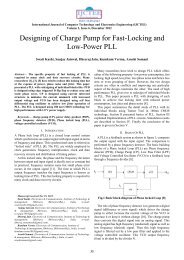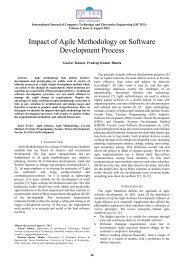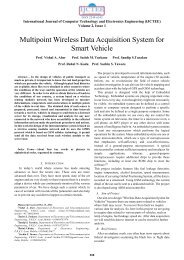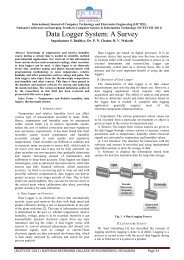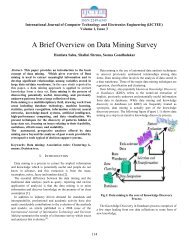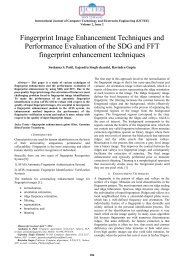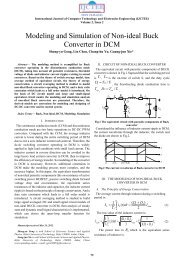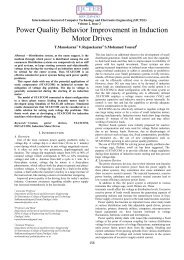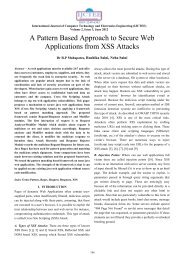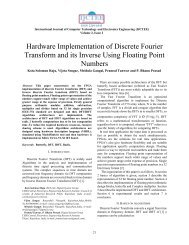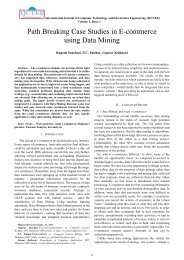Effect of Turbo Coding on OFDM Transmission to Improve BER
Effect of Turbo Coding on OFDM Transmission to Improve BER
Effect of Turbo Coding on OFDM Transmission to Improve BER
You also want an ePaper? Increase the reach of your titles
YUMPU automatically turns print PDFs into web optimized ePapers that Google loves.
ISSN 2249-6343<br />
Internati<strong>on</strong>al Journal <str<strong>on</strong>g>of</str<strong>on</strong>g> Computer Technology and Electr<strong>on</strong>ics Engineering (IJCTEE)<br />
Volume 2, Issue 1<br />
<str<strong>on</strong>g>Effect</str<strong>on</strong>g> <str<strong>on</strong>g>of</str<strong>on</strong>g> <str<strong>on</strong>g>Turbo</str<strong>on</strong>g> <str<strong>on</strong>g>Coding</str<strong>on</strong>g> <strong>on</strong> <strong>OFDM</strong> Transmissi<strong>on</strong> <strong>to</strong><br />
<strong>Improve</strong> <strong>BER</strong><br />
Dhiraj G. Agrawal 1 , Roma K. Paliwal 2 , Priti Subramanium 3<br />
Abstract-A model <str<strong>on</strong>g>of</str<strong>on</strong>g> <str<strong>on</strong>g>Turbo</str<strong>on</strong>g> code based <strong>on</strong> <strong>OFDM</strong><br />
(Orthog<strong>on</strong>al Frequency Divisi<strong>on</strong> Multiplexing) is proposed<br />
in this paper. Orthog<strong>on</strong>al Frequency Divisi<strong>on</strong> Multiplexing<br />
(<strong>OFDM</strong>) has become a popular modulati<strong>on</strong> method in high<br />
speed wireless communicati<strong>on</strong>s. By partiti<strong>on</strong>ing a wideband<br />
fading channel in<strong>to</strong> flat narrowband channels, <strong>OFDM</strong> is able<br />
<strong>to</strong> mitigate the detrimental effects <str<strong>on</strong>g>of</str<strong>on</strong>g> multipath fading using a<br />
simple <strong>on</strong>e-tap equalizer. There is a growing need <strong>to</strong> quickly<br />
transmit informati<strong>on</strong> wirelessly and accurately. <strong>OFDM</strong> is a<br />
suitable candidate for high data rate transmissi<strong>on</strong> with<br />
forward error correcti<strong>on</strong> (FEC) methods over wireless<br />
channels. In this project the system throughput <str<strong>on</strong>g>of</str<strong>on</strong>g> a working<br />
<strong>OFDM</strong> system has been enhanced by adding turbo coding.<br />
The use <str<strong>on</strong>g>of</str<strong>on</strong>g> turbo coding and power allocati<strong>on</strong> in <strong>OFDM</strong> is<br />
useful <strong>to</strong> the desired performance at higher data rates.<br />
Simulati<strong>on</strong> is <strong>to</strong> be d<strong>on</strong>e over additive white Gaussian noise<br />
(AWGN) and impulsive noise (which is produced in<br />
broadband transmissi<strong>on</strong>) channels. The wideband system has<br />
48 data sub-channels; each is individually modulated<br />
according <strong>to</strong> channel state informati<strong>on</strong> acquired during the<br />
previous burst. This project is <strong>to</strong> increase the system<br />
throughput while maintaining system performance under a<br />
desired bit error rate (<strong>BER</strong>). To improve the performance <str<strong>on</strong>g>of</str<strong>on</strong>g><br />
the uncoded <strong>OFDM</strong> signal by c<strong>on</strong>voluti<strong>on</strong> coding[1].<br />
Keywords: Bit error rate, Orthog<strong>on</strong>al frequency divisi<strong>on</strong><br />
multiplexing, <str<strong>on</strong>g>Turbo</str<strong>on</strong>g> codes,<br />
I. INTRODUCTION<br />
The telecommunicati<strong>on</strong>s‟ industry is in the midst <str<strong>on</strong>g>of</str<strong>on</strong>g> a<br />
veritable explosi<strong>on</strong> in wireless technologies. Once<br />
exclusively military, satellite and cellular technologies are<br />
now commercially driven by ever more demanding<br />
c<strong>on</strong>sumers, who are ready for seamless communicati<strong>on</strong><br />
from their home <strong>to</strong> their car, <strong>to</strong> their <str<strong>on</strong>g>of</str<strong>on</strong>g>fice, or even for<br />
outdoor activities. With this increased demand comes a<br />
growing need <strong>to</strong> transmit informati<strong>on</strong> wirelessly, quickly,<br />
and accurately. To address this need, communicati<strong>on</strong>s<br />
engineer have combined technologies suitable for high rate<br />
transmissi<strong>on</strong> with forward error correcti<strong>on</strong> techniques. The<br />
latter are particularly important as wireless<br />
communicati<strong>on</strong>s channels are far more hostile as opposed<br />
<strong>to</strong> wire alternatives, and the need for mobility proves<br />
especially challenging for reliable communicati<strong>on</strong>s.<br />
Orthog<strong>on</strong>al Frequency Divisi<strong>on</strong> Multiplexing (<strong>OFDM</strong>) is a<br />
Multi-Carrier Modulati<strong>on</strong> technique in which a single high<br />
rate data-stream is divided in<strong>to</strong> multiple low rate datastreams<br />
and is modulated using sub-carriers which are<br />
orthog<strong>on</strong>al <strong>to</strong> each other . Some <str<strong>on</strong>g>of</str<strong>on</strong>g> the main advantages <str<strong>on</strong>g>of</str<strong>on</strong>g><br />
<strong>OFDM</strong> are its multi-path delay spread <strong>to</strong>lerance and<br />
efficient spectral usage by allowing overlapping in the<br />
frequency domain.<br />
Also <strong>on</strong>e other significant advantage is that the<br />
modulati<strong>on</strong> and demodulati<strong>on</strong> can be d<strong>on</strong>e using inverse<br />
fast fourier transmissi<strong>on</strong> (IFFT) and fast fourier<br />
transmissi<strong>on</strong> (FFT) operati<strong>on</strong>s, which are computati<strong>on</strong>ally<br />
efficient. In a single <strong>OFDM</strong> transmissi<strong>on</strong> all the subcarriers<br />
are synchr<strong>on</strong>ized <strong>to</strong> each other, restricting the transmissi<strong>on</strong><br />
<strong>to</strong> digital modulati<strong>on</strong> schemes. <strong>OFDM</strong> is symbol based,<br />
and can be thought <str<strong>on</strong>g>of</str<strong>on</strong>g> as a large number <str<strong>on</strong>g>of</str<strong>on</strong>g> low bit rate<br />
carriers transmitting in parallel. All these carriers<br />
transmitted using synchr<strong>on</strong>ized time and frequency,<br />
forming a single block <str<strong>on</strong>g>of</str<strong>on</strong>g> spectrum. This is <strong>to</strong> ensure that<br />
the orthog<strong>on</strong>al nature <str<strong>on</strong>g>of</str<strong>on</strong>g> the structure is maintained. Since<br />
these multiple carriers form a single <strong>OFDM</strong> transmissi<strong>on</strong>,<br />
they are comm<strong>on</strong>ly referred <strong>to</strong> as „subcarriers‟, with the<br />
term <str<strong>on</strong>g>of</str<strong>on</strong>g> „carrier‟ reserved for describing the RF carrier<br />
mixing the signal from base band. There are several ways<br />
<str<strong>on</strong>g>of</str<strong>on</strong>g> looking at what make the subcarriers in an <strong>OFDM</strong><br />
signal orthog<strong>on</strong>al and why this prevents interference<br />
between them<br />
This project enhances the throughput <str<strong>on</strong>g>of</str<strong>on</strong>g> an existing<br />
<strong>OFDM</strong> system by implementing adaptive modulati<strong>on</strong> and<br />
turbo coding. The new system guarantees <strong>to</strong> reach a target<br />
performance <strong>BER</strong> <str<strong>on</strong>g>of</str<strong>on</strong>g> 10 -2 over a slow time-varying fading<br />
channel. The system au<strong>to</strong>matically switches from lower <strong>to</strong><br />
higher modulati<strong>on</strong> schemes <strong>on</strong> individual subcarriers,<br />
depending <strong>on</strong> the state <str<strong>on</strong>g>of</str<strong>on</strong>g> the quasi-stati<strong>on</strong>ary channel. In<br />
c<strong>on</strong>juncti<strong>on</strong> with the adaptive design, forward error<br />
correcti<strong>on</strong> is performed by using turbo codes. The<br />
combinati<strong>on</strong> <str<strong>on</strong>g>of</str<strong>on</strong>g> parallel c<strong>on</strong>catenati<strong>on</strong> and recursive<br />
decoding allows these codes <strong>to</strong> achieve near Shann<strong>on</strong>‟s<br />
limit performance in the turbo cliff regi<strong>on</strong> [6]. All this is<br />
simulated in MATLAB programming.<br />
The rest <str<strong>on</strong>g>of</str<strong>on</strong>g> the paper is organized as follows. In secti<strong>on</strong><br />
II, we introduce <strong>OFDM</strong> transceiver model. In secti<strong>on</strong> III,<br />
briefly review the <str<strong>on</strong>g>Turbo</str<strong>on</strong>g> code design criteria. In secti<strong>on</strong><br />
IV, The Simulati<strong>on</strong> model is presented al<strong>on</strong>g with their<br />
implementati<strong>on</strong> issues. The simulati<strong>on</strong> results are<br />
presented in secti<strong>on</strong> V, and some c<strong>on</strong>clusi<strong>on</strong>s and future<br />
work are drawn in secti<strong>on</strong> 6.<br />
II. <strong>OFDM</strong> SYSTEM<br />
Orthog<strong>on</strong>al frequency divisi<strong>on</strong> multiplexing (<strong>OFDM</strong>)<br />
is nowadays widely used for achieving high data rates as<br />
well as combating multipath fading in wireless<br />
communicati<strong>on</strong>s. In this multi-carrier modulati<strong>on</strong> scheme<br />
data is transmitted by dividing a single wideband stream<br />
in<strong>to</strong> several smaller or narrowband parallel bit streams.<br />
94
Each narrowband stream is modulated <strong>on</strong><strong>to</strong> an<br />
individual carrier. The narrowband channels are orthog<strong>on</strong>al<br />
vis-à-vis each other, and are transmitted simultaneously. In<br />
doing so, the symbol durati<strong>on</strong> is increased proporti<strong>on</strong>ately,<br />
which reduces the effects <str<strong>on</strong>g>of</str<strong>on</strong>g> inter-symbol interference (ISI)<br />
induced by multipath Rayleigh-faded envir<strong>on</strong>ments. The<br />
spectra <str<strong>on</strong>g>of</str<strong>on</strong>g> the subcarriers overlap each other, making<br />
<strong>OFDM</strong> more spectral efficient as opposed <strong>to</strong> c<strong>on</strong>venti<strong>on</strong>al<br />
multicarrier communicati<strong>on</strong> schemes.<br />
A. <strong>OFDM</strong> message<br />
The <strong>OFDM</strong> message is generated in the complex<br />
baseband. Each symbol is modulated <strong>on</strong><strong>to</strong> the<br />
corresp<strong>on</strong>ding subcarrier using variants <str<strong>on</strong>g>of</str<strong>on</strong>g> phase shift<br />
keying (PSK) or different forms <str<strong>on</strong>g>of</str<strong>on</strong>g> quadrature amplitude<br />
modulati<strong>on</strong> (QAM). The data symbols are c<strong>on</strong>verted from<br />
serial <strong>to</strong> parallel before data transmissi<strong>on</strong>. The frequency<br />
spacing between adjacent subcarriers is Nπ2, where N is<br />
the number <str<strong>on</strong>g>of</str<strong>on</strong>g> subcarriers. This can be achieved by using<br />
the inverse discrete Fourier transform (IDFT), easily<br />
implemented as the inverse fast Fourier transform (IFFT)<br />
operati<strong>on</strong>. As a result, the <strong>OFDM</strong> symbol generated for an<br />
N-subcarrier system translates in<strong>to</strong> N samples, with the ith<br />
sample being<br />
B. Interference<br />
In a multipath envir<strong>on</strong>ment, different versi<strong>on</strong>s <str<strong>on</strong>g>of</str<strong>on</strong>g> the<br />
transmitted symbol reach the receiver at different times.<br />
This is due <strong>to</strong> the fact that different propagati<strong>on</strong> paths exist<br />
between transmitter and receiver. As a result, the time<br />
dispersi<strong>on</strong> stretches a particular received symbol in<strong>to</strong> the<br />
<strong>on</strong>e following it. This symbol overlap is called intersymbol<br />
interference, or ISI. It also is a major fac<strong>to</strong>r in<br />
timing <str<strong>on</strong>g>of</str<strong>on</strong>g>fset. One other form <str<strong>on</strong>g>of</str<strong>on</strong>g> interference is intercarrier<br />
interference or ICI. In <strong>OFDM</strong>, successful<br />
demodulati<strong>on</strong> depends <strong>on</strong> maintaining orthog<strong>on</strong>ality<br />
between the carriers. We demodulate a specific subcarrier<br />
N at its spectral peak, meaning that all the other carriers<br />
must have a corresp<strong>on</strong>ding zero spectra at the Nth center<br />
frequency (frequency domain perspective). Frequency<br />
<str<strong>on</strong>g>of</str<strong>on</strong>g>fsets lead <strong>to</strong> this criteri<strong>on</strong> not being met. This c<strong>on</strong>diti<strong>on</strong><br />
can seriously hinder the performance <str<strong>on</strong>g>of</str<strong>on</strong>g> our <strong>OFDM</strong><br />
system. Graph 3.1 below shows that when the decisi<strong>on</strong> is<br />
not taken at the correct center frequency (i.e. peak) <str<strong>on</strong>g>of</str<strong>on</strong>g><br />
carrier c<strong>on</strong>sidered, adjacent carriers fac<strong>to</strong>r in the decisi<strong>on</strong><br />
making, thus reducing the performance <str<strong>on</strong>g>of</str<strong>on</strong>g> the system[2].<br />
At the receiver, the <strong>OFDM</strong> message goes through the exact<br />
opposite operati<strong>on</strong> in the discrete Fourier transform (DFT)<br />
<strong>to</strong> take the corrupted symbols from a time domain form<br />
in<strong>to</strong> the frequency domain. In practice, the baseband<br />
<strong>OFDM</strong> receiver performs the fast Fourier transform (FFT)<br />
<str<strong>on</strong>g>of</str<strong>on</strong>g> the receive message <strong>to</strong> recover the informati<strong>on</strong> that was<br />
originally sent[2].<br />
Figure 2 <str<strong>on</strong>g>Effect</str<strong>on</strong>g> <str<strong>on</strong>g>of</str<strong>on</strong>g> Frequency Offset (Maintaining<br />
Orthog<strong>on</strong>ality)<br />
C. The Cyclic Prefix<br />
Figure 1 Basic <strong>OFDM</strong> System Architecture<br />
Figure 3. Cyclic Prefix<br />
95
<strong>OFDM</strong> demodulati<strong>on</strong> must be synchr<strong>on</strong>ized both in the<br />
time domain as well as in the frequency domain. Engineers<br />
have found a way <strong>to</strong> ensure that goal by adding a guard<br />
time in the form <str<strong>on</strong>g>of</str<strong>on</strong>g> a cyclic prefix (CP) <strong>to</strong> each <strong>OFDM</strong><br />
symbol. The CP c<strong>on</strong>sists in duplicates <str<strong>on</strong>g>of</str<strong>on</strong>g> the end samples<br />
<str<strong>on</strong>g>of</str<strong>on</strong>g> the <strong>OFDM</strong> message relocated at the beginning <str<strong>on</strong>g>of</str<strong>on</strong>g> the<br />
<strong>OFDM</strong> symbol. This increase the length T <str<strong>on</strong>g>of</str<strong>on</strong>g> the<br />
sym<br />
transmit message without altering its frequency spectrum.<br />
T sym = CP + T data N<br />
where T is the durati<strong>on</strong> <str<strong>on</strong>g>of</str<strong>on</strong>g> <strong>on</strong>e data symbol, and N the<br />
data<br />
number <str<strong>on</strong>g>of</str<strong>on</strong>g> carriers. The receiver is set <strong>to</strong> demodulate over<br />
a complete <strong>OFDM</strong> symbol period, which maintains<br />
orthog<strong>on</strong>ality. As l<strong>on</strong>g as the CP, is l<strong>on</strong>ger than the<br />
channel delay spread, τ<br />
max<br />
, the system will not suffer from<br />
ISI. The CP is <strong>to</strong> be added after the FFT operati<strong>on</strong> at the<br />
transmitter and removed prior <strong>to</strong> demodulati<strong>on</strong>. The figure<br />
below whose the deteriotiati<strong>on</strong> in performance when the<br />
CP is closely matched by the delay spread. The signal<br />
c<strong>on</strong>stellati<strong>on</strong> is less tightly grouped, no doubt a sign <str<strong>on</strong>g>of</str<strong>on</strong>g> less<br />
than accurate decoding.<br />
• The utilizati<strong>on</strong> <str<strong>on</strong>g>of</str<strong>on</strong>g> s<str<strong>on</strong>g>of</str<strong>on</strong>g>t input s<str<strong>on</strong>g>of</str<strong>on</strong>g>t output decoding. Instead<br />
<str<strong>on</strong>g>of</str<strong>on</strong>g> using hard decisi<strong>on</strong>s, the decoder uses the probabilities<br />
<str<strong>on</strong>g>of</str<strong>on</strong>g> the received data <strong>to</strong> generate s<str<strong>on</strong>g>of</str<strong>on</strong>g>t output which also<br />
c<strong>on</strong>tain informati<strong>on</strong> about the degree <str<strong>on</strong>g>of</str<strong>on</strong>g> certainty <str<strong>on</strong>g>of</str<strong>on</strong>g> the<br />
output bits.<br />
• This is achieved by using an interleaver. Encoders and<br />
decoders working <strong>on</strong> permuted versi<strong>on</strong>s <str<strong>on</strong>g>of</str<strong>on</strong>g> the same<br />
informati<strong>on</strong>.<br />
An iterative decoding algorithm centered around the last<br />
two c<strong>on</strong>cept would refine its output with each pass, thus<br />
resembling the turbo engine used in airplanes. Hence, the<br />
name <str<strong>on</strong>g>Turbo</str<strong>on</strong>g> was used <strong>to</strong> refer <strong>to</strong> the process.<br />
A. Encoders for <str<strong>on</strong>g>Turbo</str<strong>on</strong>g> Codes<br />
The encoder for a turbo code is a parallel c<strong>on</strong>catenated<br />
c<strong>on</strong>voluti<strong>on</strong>al code. Figure 3.4 shows a block diagram <str<strong>on</strong>g>of</str<strong>on</strong>g><br />
the encoder first presented by Berrou et al [10]. The binary<br />
input data sequence is represented by d k = (d 1 ….d N ) the<br />
input sequence is passed in<strong>to</strong> the input <str<strong>on</strong>g>of</str<strong>on</strong>g> a c<strong>on</strong>voluti<strong>on</strong>al<br />
encoder [8], ENC 1 and a coded bit stream, generated.<br />
The data sequence is then interleaved. That is, the bits are<br />
loaded in<strong>to</strong> a matrix and read out in a way so as <strong>to</strong> spread<br />
the positi<strong>on</strong>s <str<strong>on</strong>g>of</str<strong>on</strong>g> the input bits. The bits are <str<strong>on</strong>g>of</str<strong>on</strong>g>ten read out in<br />
a pseudo random manner. The interleaved data sequence is<br />
passed <strong>to</strong> a sec<strong>on</strong>d c<strong>on</strong>voluti<strong>on</strong>al encoder ENC 2 , and a<br />
sec<strong>on</strong>d coded bit stream, is generated. The code<br />
sequence that is passed <strong>to</strong> the modula<strong>to</strong>r for transmissi<strong>on</strong> is<br />
a multiplexed (and possibly punctured) stream c<strong>on</strong>sisting<br />
<str<strong>on</strong>g>of</str<strong>on</strong>g> systematic code bits and parity bits from both the<br />
first encoder and the sec<strong>on</strong>d encoder .<br />
Figure 4. 64QAM Signal C<strong>on</strong>stellati<strong>on</strong> Diagrams for a<br />
64-Subcarrier <strong>OFDM</strong> System with Flat Rayleigh<br />
Fading. (A) The Cyclic Prefix is L<strong>on</strong>g Enough <strong>to</strong> Cover<br />
The Delay Spread. (B) The Cyclic Prefix is Closer <strong>to</strong><br />
Being Matched be the Delay Spread.<br />
III. TURBO CODES<br />
The combinati<strong>on</strong> <str<strong>on</strong>g>of</str<strong>on</strong>g> turbo codes with the <strong>OFDM</strong><br />
transmissi<strong>on</strong> is so called <str<strong>on</strong>g>Turbo</str<strong>on</strong>g> Coded <strong>OFDM</strong> (TC-<br />
<strong>OFDM</strong>) can yield significant improvements in terms <str<strong>on</strong>g>of</str<strong>on</strong>g><br />
lower energy needed <strong>to</strong> transmit data, a very improvement<br />
issue is in pers<strong>on</strong>nel communicati<strong>on</strong> devices [1]-[2]-[20].<br />
<str<strong>on</strong>g>Turbo</str<strong>on</strong>g> codes were first presented at the Internati<strong>on</strong>al<br />
C<strong>on</strong>ference <strong>on</strong> Communicati<strong>on</strong>s in 1993. Until then, it was<br />
widely believed that <strong>to</strong> achieve near Shann<strong>on</strong>‟s bound<br />
performance, <strong>on</strong>e would need <strong>to</strong> implement a decoder with<br />
infinite complexity or close. Parallel c<strong>on</strong>catenated codes,<br />
as they are also known, can be implemented by using<br />
either block codes (PCBC) or c<strong>on</strong>voluti<strong>on</strong>al codes<br />
(PCCC). PCCC resulted from the combinati<strong>on</strong> <str<strong>on</strong>g>of</str<strong>on</strong>g> three<br />
ideas that were known <strong>to</strong> all in the coding community:<br />
• The transforming <str<strong>on</strong>g>of</str<strong>on</strong>g> comm<strong>on</strong>ly used n<strong>on</strong>-systematic<br />
c<strong>on</strong>voluti<strong>on</strong>al codes in<strong>to</strong> systematic c<strong>on</strong>voluti<strong>on</strong>al<br />
codes.<br />
Figure 5. Structure <str<strong>on</strong>g>of</str<strong>on</strong>g> a <str<strong>on</strong>g>Turbo</str<strong>on</strong>g> Encoder<br />
B. RSC Comp<strong>on</strong>ent Codes<br />
ENC 1 and ENC 2 are Recursive Systematic<br />
C<strong>on</strong>voluti<strong>on</strong>al (RSC) codes that is, c<strong>on</strong>voluti<strong>on</strong>al codes<br />
which use feedback (they are „recursive‟) and in which the<br />
uncoded data bits appear in the transmitted code bit<br />
sequence (they are „systematic‟). A simple RSC encoder is<br />
shown in Figure 3.5 al<strong>on</strong>g with a n<strong>on</strong>-systematic (NSC)<br />
encoder, for comparis<strong>on</strong>. The RSC encoder is rate 1/2,<br />
with c<strong>on</strong>straint length K=3, and genera<strong>to</strong>r polynomial<br />
where g1 is the feedback<br />
c<strong>on</strong>nectivity and g2 is the output c<strong>on</strong>nectivity, in octal<br />
notati<strong>on</strong>. An RSC comp<strong>on</strong>ent encoder has two output<br />
sequences. One is the data sequence;<br />
the other is the parity sequence<br />
.<br />
96
To understand why RSC comp<strong>on</strong>ent codes are used in a<br />
turbo code encoder, rather than the c<strong>on</strong>venti<strong>on</strong>al NSC<br />
codes, it is necessary <strong>to</strong> first discuss the structure <str<strong>on</strong>g>of</str<strong>on</strong>g> error<br />
c<strong>on</strong>trol codes. The minimum number <str<strong>on</strong>g>of</str<strong>on</strong>g> errors an error<br />
c<strong>on</strong>trol code can correct is determined by the minimum<br />
Hamming distance <str<strong>on</strong>g>of</str<strong>on</strong>g> the code – the minimum number <str<strong>on</strong>g>of</str<strong>on</strong>g><br />
bit positi<strong>on</strong>s in which any two codewords differ. The linear<br />
nature <str<strong>on</strong>g>of</str<strong>on</strong>g> turbo codes (at least, those using BPSK/QPSK<br />
modulati<strong>on</strong>s) means that the minimum Hamming distance<br />
<str<strong>on</strong>g>of</str<strong>on</strong>g> the code can be determined by comparing each possible<br />
codeword with the all-zeroes codeword. This process<br />
simplifies analysis <str<strong>on</strong>g>of</str<strong>on</strong>g> the code somewhat, and the<br />
minimum Hamming distance is then equal <strong>to</strong> the minimum<br />
code weight (number <str<strong>on</strong>g>of</str<strong>on</strong>g> „1‟s) which occurs in any<br />
codeword. The minimum Hamming distance tends <strong>to</strong><br />
determine the <strong>BER</strong> performance <str<strong>on</strong>g>of</str<strong>on</strong>g> the code at high SNR -<br />
the asymp<strong>to</strong>tic performance. A high minimum Hamming<br />
distance results in a steep rate <str<strong>on</strong>g>of</str<strong>on</strong>g> fall <str<strong>on</strong>g>of</str<strong>on</strong>g> <strong>BER</strong> as SNR<br />
becomes large, whereas a low value results in a slow rate<br />
<str<strong>on</strong>g>of</str<strong>on</strong>g> fall. In the case <str<strong>on</strong>g>of</str<strong>on</strong>g> a turbo code, this rate <str<strong>on</strong>g>of</str<strong>on</strong>g> fall at high<br />
SNR is so slow; it is termed an error floor. At low SNR,<br />
however, codewords with code weights larger than the<br />
minimum value must be c<strong>on</strong>sidered. It is then that the<br />
overall distance spectrum <str<strong>on</strong>g>of</str<strong>on</strong>g> the code becomes important.<br />
(a)NSC<br />
(b) RSC<br />
Figure 6. Example <str<strong>on</strong>g>of</str<strong>on</strong>g> (a) N<strong>on</strong>-Systematic C<strong>on</strong>voluti<strong>on</strong>al<br />
(NSC) (b) Recursive Systematic C<strong>on</strong>voluti<strong>on</strong>al (RSC)<br />
Encoders<br />
This is the relati<strong>on</strong>ship between the code weight and the<br />
number <str<strong>on</strong>g>of</str<strong>on</strong>g> codewords with that code weight. Now, RSC<br />
codes have an infinite impulse resp<strong>on</strong>se. That is, if a data<br />
sequence c<strong>on</strong>sisting <str<strong>on</strong>g>of</str<strong>on</strong>g> a „1‟ followed by a series <str<strong>on</strong>g>of</str<strong>on</strong>g> „0‟s<br />
enters the RSC encoder, a code sequence will be generated<br />
c<strong>on</strong>taining both <strong>on</strong>es and zeroes for as l<strong>on</strong>g as the<br />
subsequent data bits remain zero. This property means that<br />
RSC encoders will tend <strong>to</strong> generate high weight code<br />
sequences for groups <str<strong>on</strong>g>of</str<strong>on</strong>g> data bits spread far apart in the<br />
input sequence.<br />
An NSC code, however, will return <strong>to</strong> the all-zeroes state<br />
after K-1 input zeroes, where K is the c<strong>on</strong>straint length <str<strong>on</strong>g>of</str<strong>on</strong>g><br />
the encoder. The infinite impulse resp<strong>on</strong>se property <str<strong>on</strong>g>of</str<strong>on</strong>g><br />
RSC codes is complemented in turbo codes by the<br />
interleaver between comp<strong>on</strong>ent encoders. An interleaver is<br />
a device for permuting a sequence <str<strong>on</strong>g>of</str<strong>on</strong>g> bits (or symbols) at<br />
its input in<strong>to</strong> an alternate sequence with a different<br />
ordering at the output.<br />
<str<strong>on</strong>g>Turbo</str<strong>on</strong>g> codes tend <strong>to</strong> make use <str<strong>on</strong>g>of</str<strong>on</strong>g> pseudo-random<br />
interleavers, whose role is <strong>to</strong> ensure that most groups <str<strong>on</strong>g>of</str<strong>on</strong>g><br />
data bits which are close <strong>to</strong>gether when entering <strong>on</strong>e RSC<br />
encoder are spread far apart before entering the other RSC<br />
encoder. The result is a composite codeword which will<br />
<str<strong>on</strong>g>of</str<strong>on</strong>g>ten have a high code weight. The details <str<strong>on</strong>g>of</str<strong>on</strong>g> interleaving<br />
will be discussed in more detail in the next secti<strong>on</strong>. This<br />
does not, however, mean that turbo codes tend <strong>to</strong> exhibit<br />
high minimum Hamming distances, and therefore good<br />
asymp<strong>to</strong>tic performance. In fact, the opposite is usually<br />
true. We shall see in the following chapter that the pseudorandom<br />
nature <str<strong>on</strong>g>of</str<strong>on</strong>g> most turbo code interleavers tends <strong>to</strong><br />
result in a mapping such that a few combinati<strong>on</strong>s <str<strong>on</strong>g>of</str<strong>on</strong>g> input<br />
bit positi<strong>on</strong>s which cause low code weight sequences in<br />
<strong>on</strong>e RSC comp<strong>on</strong>ent code are permuted in<strong>to</strong> combinati<strong>on</strong>s<br />
<str<strong>on</strong>g>of</str<strong>on</strong>g> positi<strong>on</strong>s which generate low code weight sequences in<br />
the sec<strong>on</strong>d RSC code. The result in such a case is a low<br />
composite code weight. Such pseudo-random mappings<br />
<str<strong>on</strong>g>of</str<strong>on</strong>g>ten lead <strong>to</strong> turbo codes having a low minimum code<br />
weight compared <strong>to</strong>, say, NSC-based c<strong>on</strong>voluti<strong>on</strong>al codes,<br />
resulting in a marked error floor at high SNR. It is clear<br />
from this brief discussi<strong>on</strong> that interleaver design is crucial<br />
in ensuring that a turbo code/interleaver combinati<strong>on</strong> has<br />
the lowest possible error floor. It was menti<strong>on</strong>ed earlier<br />
that at low SNR, the distance spectrum <str<strong>on</strong>g>of</str<strong>on</strong>g> the code as a<br />
whole becomes significant in determining <strong>BER</strong><br />
performance, and that the combinati<strong>on</strong> <str<strong>on</strong>g>of</str<strong>on</strong>g> RSC code and<br />
pseudorandom interleaving produces codewords with<br />
higher code weights most <str<strong>on</strong>g>of</str<strong>on</strong>g> the time. This results in there<br />
being fewer codewords with relatively low code weights<br />
than a comparable c<strong>on</strong>voluti<strong>on</strong>al code. It shall be shown<br />
later in c<strong>on</strong>structing theoretical bounds for turbo codes that<br />
it is the number <str<strong>on</strong>g>of</str<strong>on</strong>g> codewords at each weight, as well as the<br />
actual code weight, which determines the error probability<br />
<str<strong>on</strong>g>of</str<strong>on</strong>g> a code. The low multiplicity <str<strong>on</strong>g>of</str<strong>on</strong>g> low code weight<br />
sequences associated with turbo codes sometimes referred<br />
<strong>to</strong> as spectral thinning, leads <strong>to</strong> their good <strong>BER</strong><br />
performance at low SNR. A full analysis <str<strong>on</strong>g>of</str<strong>on</strong>g> the turbo code<br />
characteristics described here is given in [8].<br />
C. Interleaving<br />
It was menti<strong>on</strong>ed in the previous secti<strong>on</strong> that an<br />
interleaver is a device for reordering a sequence <str<strong>on</strong>g>of</str<strong>on</strong>g> bits or<br />
symbols. A familiar role <str<strong>on</strong>g>of</str<strong>on</strong>g> interleavers in communicati<strong>on</strong>s<br />
is that <str<strong>on</strong>g>of</str<strong>on</strong>g> the symbol interleaver which is used after error<br />
c<strong>on</strong>trol coding and signal mapping <strong>to</strong> ensure that fading<br />
bursts affecting blocks <str<strong>on</strong>g>of</str<strong>on</strong>g> symbols transmitted over the<br />
channel are broken up at the receiver by a de-interleaver,<br />
prior <strong>to</strong> decoding. Most error c<strong>on</strong>trol codes work much<br />
better when errors in the received sequence are spread far<br />
apart. Another role is that <str<strong>on</strong>g>of</str<strong>on</strong>g> the interleaver between<br />
comp<strong>on</strong>ent codes in a serially c<strong>on</strong>catenated code scheme;<br />
97
for example, between a Reed Solom<strong>on</strong> outer code and a<br />
c<strong>on</strong>voluti<strong>on</strong>al inner code. The trellis decoding nature <str<strong>on</strong>g>of</str<strong>on</strong>g><br />
most c<strong>on</strong>voluti<strong>on</strong>al codes means that uncorrected errors at<br />
the output <str<strong>on</strong>g>of</str<strong>on</strong>g> the decoder will tend <strong>to</strong> occur in bursts. The<br />
interleaving between the two comp<strong>on</strong>ent codes then<br />
ensures that these bursts are adequately spread before<br />
entering the outer decoder. In both these examples, the<br />
interleaver is typically implemented as a block interleaver.<br />
This is a rectangular matrix such that bits or symbols are<br />
written in <strong>on</strong>e row at a time, and then read out <strong>on</strong>e column<br />
at a time. Thus bits or symbols which were adjacent <strong>on</strong><br />
writing are spaced apart by the number <str<strong>on</strong>g>of</str<strong>on</strong>g> rows when<br />
reading. The de-interleaving process is simply the inverse<br />
<str<strong>on</strong>g>of</str<strong>on</strong>g> this; writing in column by column and reading out row<br />
by row, <strong>to</strong> achieve the original bit or symbol ordering.<br />
Block interleaving is simple <strong>to</strong> implement, and suitable<br />
where the objective is <strong>to</strong> spread bursts <str<strong>on</strong>g>of</str<strong>on</strong>g> errors evenly by<br />
as large a distance as possible. Block interleavers are not<br />
suitable as turbo code interleavers, because they tend <strong>to</strong><br />
generate large numbers <str<strong>on</strong>g>of</str<strong>on</strong>g> codewords with a relatively low<br />
weight, and therefore with a relatively low hamming<br />
distance between them, due <strong>to</strong> the regularity <str<strong>on</strong>g>of</str<strong>on</strong>g> the<br />
spreading process. Berrou and Glavieux introduced<br />
pseudo-random interleaving in<strong>to</strong> turbo codes <strong>to</strong> solve this<br />
problem. A pseudo-random interleaver is a random<br />
mapping between input and output positi<strong>on</strong>s, generated by<br />
means <str<strong>on</strong>g>of</str<strong>on</strong>g> some form <str<strong>on</strong>g>of</str<strong>on</strong>g> pseudo-random number genera<strong>to</strong>r.<br />
Figure 3.6 shows a simple illustrati<strong>on</strong> <str<strong>on</strong>g>of</str<strong>on</strong>g> pseudo-random<br />
interleaving. The original data sequence is represented by<br />
the sequence <str<strong>on</strong>g>of</str<strong>on</strong>g> white squares, and the interleaved data<br />
sequence is represented by the grey squares. <str<strong>on</strong>g>Turbo</str<strong>on</strong>g> code<br />
<strong>BER</strong> performance improves with interleaver length - the so<br />
called interleaver gain - but the loading and unloading <str<strong>on</strong>g>of</str<strong>on</strong>g><br />
the interleaver adds a c<strong>on</strong>siderable delay <strong>to</strong> the decoding<br />
process. This would make a 256x256 interleaver unsuitable<br />
for, say, and real time speech applicati<strong>on</strong>s, which are delay<br />
sensitive.<br />
D. Puncturing<br />
Different code rates are achieved by puncturing the<br />
parity bit sequences and . Puncturing the data bit<br />
sequence leads <strong>to</strong> a severe degradati<strong>on</strong> in turbo code<br />
performance. Figure 3.4 illustrates the puncturing process.<br />
A number „1‟ in the tables represents a code bit that is<br />
included in the transmitted code bit sequence, and a<br />
number „0‟ represents a code bit that is excluded, or<br />
punctured. On the right <str<strong>on</strong>g>of</str<strong>on</strong>g> each table is the list <str<strong>on</strong>g>of</str<strong>on</strong>g> code bits<br />
which are included in the transmitted code sequence. In a),<br />
the code is unpunctured and is <str<strong>on</strong>g>of</str<strong>on</strong>g> code rate 1/3 whereas in<br />
b), alternate parity bits from each comp<strong>on</strong>ent encoder are<br />
punctured at each time interval k. The result is a rate 1/2<br />
codes. In c), the code is more heavily punctured, <strong>to</strong> form a<br />
rate codes 3/ 4[20].<br />
E. Terminati<strong>on</strong><br />
In c<strong>on</strong>trast <strong>to</strong> block codes, c<strong>on</strong>voluti<strong>on</strong>al codes do not<br />
have a fixed block length. C<strong>on</strong>voluti<strong>on</strong>al coding is a<br />
c<strong>on</strong>tinuous process, and could span an entire message,<br />
rather than a small group <str<strong>on</strong>g>of</str<strong>on</strong>g> bits. <str<strong>on</strong>g>Turbo</str<strong>on</strong>g> codes, however, do<br />
have a fixed block length, determined by the length <str<strong>on</strong>g>of</str<strong>on</strong>g> the<br />
interleaver. Tail bits are usually appended <strong>to</strong> each block <str<strong>on</strong>g>of</str<strong>on</strong>g><br />
data bits entering <strong>on</strong>e or other <str<strong>on</strong>g>of</str<strong>on</strong>g> the comp<strong>on</strong>ent encoders,<br />
<strong>to</strong> return it <strong>to</strong> the all-zeroes state at the end <str<strong>on</strong>g>of</str<strong>on</strong>g> the trellis.<br />
This process is called terminati<strong>on</strong>, and allows the MAP<br />
algorithm <strong>to</strong> make assumpti<strong>on</strong>s about the start and end<br />
trellis states. This yields better <strong>BER</strong> performance.<br />
Terminati<strong>on</strong> <str<strong>on</strong>g>of</str<strong>on</strong>g> both comp<strong>on</strong>ent encoders is more difficult,<br />
because the terminating sequence for the first encoder is<br />
interleaved and may well not, by itself, terminate the<br />
sec<strong>on</strong>d encoder. Interleaver designs have been devised [9]<br />
which interleave a terminating sequence in the first<br />
encoder in<strong>to</strong> a terminating sequence in the sec<strong>on</strong>d encoder.<br />
This tends <strong>to</strong> yield better <strong>BER</strong> performance than a single<br />
code terminating process and is another promising area for<br />
investigati<strong>on</strong>[20].<br />
(a) Rate 1/3 <str<strong>on</strong>g>Turbo</str<strong>on</strong>g> Code<br />
Figure 7. Pseudo- Random Interleaving in a <str<strong>on</strong>g>Turbo</str<strong>on</strong>g><br />
Encoder<br />
(b) Rate 1/2 <str<strong>on</strong>g>Turbo</str<strong>on</strong>g> Code<br />
Figure 8. Puncture Patterns for <str<strong>on</strong>g>Turbo</str<strong>on</strong>g> Codes<br />
98
F. <str<strong>on</strong>g>Turbo</str<strong>on</strong>g> Decoding<br />
A block diagram <str<strong>on</strong>g>of</str<strong>on</strong>g> a turbo decoder is shown in<br />
Figure 3.11. The input <strong>to</strong> the turbo decoder is a sequence<br />
<str<strong>on</strong>g>of</str<strong>on</strong>g> received code values<br />
from the<br />
demodula<strong>to</strong>r. The turbo decoder c<strong>on</strong>sists <str<strong>on</strong>g>of</str<strong>on</strong>g> two<br />
comp<strong>on</strong>ent decoders – DEC1 <strong>to</strong> decode sequences from<br />
ENC1 , and DEC2 <strong>to</strong> decode sequences from ENC2. Each<br />
<str<strong>on</strong>g>of</str<strong>on</strong>g> these decoders is a Maximum A Posteriori (MAP)<br />
decoder. DEC1 takes as its input the received sequence <str<strong>on</strong>g>of</str<strong>on</strong>g><br />
systematic values and the received sequence <str<strong>on</strong>g>of</str<strong>on</strong>g> parity<br />
values bel<strong>on</strong>ging <strong>to</strong> the first encoder ENC1. The<br />
output <str<strong>on</strong>g>of</str<strong>on</strong>g> DEC1 is a sequence <str<strong>on</strong>g>of</str<strong>on</strong>g> s<str<strong>on</strong>g>of</str<strong>on</strong>g>t estimates EXT1 <str<strong>on</strong>g>of</str<strong>on</strong>g><br />
the transmitted data its . EXT1 is called extrinsic data,<br />
in that it does not c<strong>on</strong>tain any informati<strong>on</strong> which was given<br />
<strong>to</strong> DEC1 by DEC2. This informati<strong>on</strong> is interleaved, and<br />
then passed <strong>to</strong> the sec<strong>on</strong>d decoder DEC2. The interleaver<br />
is identical <strong>to</strong> that in the encoder (Figure 3.1). DEC2 takes<br />
as its input the (interleaved) systematic received values<br />
and the sequence <str<strong>on</strong>g>of</str<strong>on</strong>g> received parity values from the<br />
sec<strong>on</strong>d encoder ENC2, al<strong>on</strong>g with the interleaved form <str<strong>on</strong>g>of</str<strong>on</strong>g><br />
the extrinsic informati<strong>on</strong> EXT1, provided by the first<br />
decoder. DEC2 outputs a set <str<strong>on</strong>g>of</str<strong>on</strong>g> values, which, when deinterleaved<br />
using an inverse form <str<strong>on</strong>g>of</str<strong>on</strong>g> the interleaver,<br />
c<strong>on</strong>stitute s<str<strong>on</strong>g>of</str<strong>on</strong>g>t estimates EXT2 <str<strong>on</strong>g>of</str<strong>on</strong>g> the transmitted data<br />
sequence . This extrinsic data, formed without the aid <str<strong>on</strong>g>of</str<strong>on</strong>g><br />
parity bits from the first code, is feedback DEC1. This<br />
procedure is repeated in a iterative manner. The iterative<br />
decoding process adds greatly <strong>to</strong> the <strong>BER</strong> performance <str<strong>on</strong>g>of</str<strong>on</strong>g><br />
turbo codes. However, after several iterati<strong>on</strong>s, the two<br />
decoders‟ estimates <str<strong>on</strong>g>of</str<strong>on</strong>g> will tend <strong>to</strong> c<strong>on</strong>verge. At this point,<br />
DEC2 outputs a value Λ( ); a log-likelihood<br />
representati<strong>on</strong> <str<strong>on</strong>g>of</str<strong>on</strong>g> the estimate <str<strong>on</strong>g>of</str<strong>on</strong>g> Λ( ). This log<br />
likelihood value takes in<strong>to</strong> account the probability <str<strong>on</strong>g>of</str<strong>on</strong>g> a<br />
transmitted „0‟ or „1‟ based <strong>on</strong> systematic informati<strong>on</strong> and<br />
parity informati<strong>on</strong> from both comp<strong>on</strong>ent codes. More<br />
negative values <str<strong>on</strong>g>of</str<strong>on</strong>g> Λ( ) represent a str<strong>on</strong>g likelihood<br />
that the transmitted bit was a „0‟ and more positive values<br />
represent a str<strong>on</strong>g likelihood that a „1‟ was transmitted. Λ<br />
( ) is de-interleaved so that its sequence coincides with<br />
that <str<strong>on</strong>g>of</str<strong>on</strong>g> the systematic and first parity streams. Then a<br />
simple threshold operati<strong>on</strong> is performed <strong>on</strong> the result, <strong>to</strong><br />
produce hard decisi<strong>on</strong> estimates, Λ( ), for the<br />
transmitted bits.<br />
The decoding estimates EXT1 and EXT2 do not<br />
necessarily c<strong>on</strong>verge <strong>to</strong> a correct bit decisi<strong>on</strong>. If a set <str<strong>on</strong>g>of</str<strong>on</strong>g><br />
corrupted code bits form a pair <str<strong>on</strong>g>of</str<strong>on</strong>g> error sequences that<br />
neither <str<strong>on</strong>g>of</str<strong>on</strong>g> the decoders is able <strong>to</strong> correct, then EXT1 and<br />
EXT2 may either diverge, or c<strong>on</strong>verge <strong>to</strong> an incorrect s<str<strong>on</strong>g>of</str<strong>on</strong>g>t<br />
value. In the next secti<strong>on</strong>s, we will look at the algorithms<br />
used in the turbo decoding process, within DEC1 and<br />
DEC2[20].<br />
Figure 9 <str<strong>on</strong>g>Turbo</str<strong>on</strong>g> Decoder Structure.<br />
IV. THE SIMULATION MODEL<br />
For simulati<strong>on</strong> purposes, we based our work <strong>on</strong> the<br />
simulati<strong>on</strong> <strong>to</strong>ol provided <strong>on</strong>line in [9]. It‟s a complete<br />
<strong>OFDM</strong> WLAN physical layer simulati<strong>on</strong> in MATLAB.<br />
The program simulates a 64 subcarrier <strong>OFDM</strong> system. The<br />
system supports up <strong>to</strong> 2 transmit and 2 receive antennas, a<br />
c<strong>on</strong>voluti<strong>on</strong>al code genera<strong>to</strong>r with rates ½, 2/3, and 3/4.<br />
The code is punctured <strong>to</strong> IEEE specificati<strong>on</strong>s. As an<br />
opti<strong>on</strong>, <strong>on</strong>e can chose <strong>to</strong> interleave the transmit bits for<br />
added protecti<strong>on</strong>. The system supports 4 modulati<strong>on</strong><br />
schemes, binary phase shift keying, quadrature phase shift<br />
keying, sixteen quadrature amplitude modulati<strong>on</strong>, and sixty<br />
four quadrature amplitude modulati<strong>on</strong>. Frequency jitter can<br />
also be added <strong>to</strong> a system that supports two channel<br />
models, namely additive white Gaussian noise, AWGN<br />
and flat Rayleigh fading. One can input the desired length<br />
<str<strong>on</strong>g>of</str<strong>on</strong>g> the delay spread. The cyclic prefix is 16 samples l<strong>on</strong>g.<br />
You can also request a specific average signal <strong>to</strong> noise<br />
ratio. Transmit power amplifier effects and phase noise<br />
dis<strong>to</strong>rti<strong>on</strong> can be added <strong>to</strong> the transmit signal. The<br />
simula<strong>to</strong>r also comes with a series <str<strong>on</strong>g>of</str<strong>on</strong>g> synchr<strong>on</strong>izati<strong>on</strong><br />
algorithms including packet detecti<strong>on</strong>, fine time<br />
synchr<strong>on</strong>izati<strong>on</strong>, frequency synchr<strong>on</strong>izati<strong>on</strong>, pilot phase<br />
tracking, channel estimati<strong>on</strong>, all <str<strong>on</strong>g>of</str<strong>on</strong>g> that if you wish <strong>to</strong><br />
simulate IEEE 802.11 standards. There is also a switch <strong>to</strong><br />
add a receiver timing <str<strong>on</strong>g>of</str<strong>on</strong>g>fset[1]- [2].<br />
Figure 10 . Simulati<strong>on</strong> model <str<strong>on</strong>g>of</str<strong>on</strong>g> TC <strong>OFDM</strong><br />
99
Here A = turbo encoder, B = QAM/QPSK modulati<strong>on</strong>, C =<br />
serial <strong>to</strong> parallel c<strong>on</strong>verter, D = IFFT, E = parallel <strong>to</strong> serial<br />
c<strong>on</strong>verter, F = channel with noise, G = serial <strong>to</strong> parallel<br />
c<strong>on</strong>verter, H = FFT, I = parallel <strong>to</strong> serial c<strong>on</strong>verter, J =<br />
AM/QPSK demodulati<strong>on</strong> and K = turbo decoder.<br />
A. Simulati<strong>on</strong> Parameters<br />
During the simulati<strong>on</strong>s, in order compare the results, the<br />
same random messages were generated. For thet radiant<br />
functi<strong>on</strong> is in MATLAB.<br />
Table 3.4 Simulati<strong>on</strong> Parameters<br />
Parameters<br />
Values<br />
QPSK,16-QAM 64-<br />
Digital Modulati<strong>on</strong><br />
QAM<br />
<str<strong>on</strong>g>Turbo</str<strong>on</strong>g> code rates<br />
½<br />
SISO Decoder<br />
Log-MAP<br />
Code Genera<strong>to</strong>r {111, 101}<br />
Interleaver Size 1 x 100<br />
B. Algorithm <str<strong>on</strong>g>of</str<strong>on</strong>g> Simulati<strong>on</strong><br />
We measured the performance <str<strong>on</strong>g>of</str<strong>on</strong>g> the turbo coded<br />
<strong>OFDM</strong> through MATLAB simulati<strong>on</strong>. The simulati<strong>on</strong><br />
follows the procedure listed below:<br />
1. Generate the informati<strong>on</strong> bits randomly.<br />
2. Encode the informati<strong>on</strong> bits using a turbo encoder with<br />
the specified genera<strong>to</strong>r matrix.<br />
3. Use QPSK or different QAM modulati<strong>on</strong> <strong>to</strong> c<strong>on</strong>vert the<br />
binary bits, 0 and 1, in<strong>to</strong> complex signals (before these<br />
modulati<strong>on</strong> use zero padding)<br />
4. Performed serial <strong>to</strong> parallel c<strong>on</strong>versi<strong>on</strong>.<br />
5. Use IFFT <strong>to</strong> generate <strong>OFDM</strong> signals, zero padding is<br />
being d<strong>on</strong>e before IFFT.<br />
6. Use parallel <strong>to</strong> serial c<strong>on</strong>ver<strong>to</strong>r <strong>to</strong> transmit signal<br />
serially.<br />
7. Introduce noise <strong>to</strong> simulate channel errors. We assume<br />
that the signals are transmitted over an AWGN channel.<br />
The noise is modeled as a Guassian random variable with<br />
zero mean and variance σ2 . The variance <str<strong>on</strong>g>of</str<strong>on</strong>g> the noise is<br />
obtained as<br />
generate a sequence <str<strong>on</strong>g>of</str<strong>on</strong>g> normally distributed random<br />
numbers, where randn has zero mean and 1 variance. Thus<br />
the<br />
received signal at the decoder is :X‟ = noisy (X)Where<br />
noisy (X) is the signal corrupted by noise.<br />
8. At the receiver side, perform reverse operati<strong>on</strong>s <strong>to</strong><br />
decode the received sequence.<br />
9. Count the number <str<strong>on</strong>g>of</str<strong>on</strong>g> err<strong>on</strong>eous bits by comparing the<br />
decoded bit sequence with the original <strong>on</strong>e.<br />
10. Calculate the <strong>BER</strong> and plot it[1].<br />
perfectly known). It is shown, however, that there is a<br />
large potential gain in using the iterative property <str<strong>on</strong>g>of</str<strong>on</strong>g> turbo<br />
decoders where s<str<strong>on</strong>g>of</str<strong>on</strong>g>t bit estimates are used <strong>to</strong>gether with<br />
the known pilot symbols. The performance <str<strong>on</strong>g>of</str<strong>on</strong>g> such an<br />
iterative estimati<strong>on</strong> scheme proves <strong>to</strong> be <str<strong>on</strong>g>of</str<strong>on</strong>g> particular<br />
interest when the channel is str<strong>on</strong>gly frequency- and<br />
time- selective [1].<br />
Similar <strong>to</strong> every other communicati<strong>on</strong>s scheme, coding<br />
can be employed <strong>to</strong> improve the performance <str<strong>on</strong>g>of</str<strong>on</strong>g> overall<br />
system. Several coding schemes, such as block codes,<br />
c<strong>on</strong>voluti<strong>on</strong>al codes and turbo codes have been<br />
investigated within <strong>OFDM</strong> systems. Moreover, the deep<br />
fades in the frequency resp<strong>on</strong>se <str<strong>on</strong>g>of</str<strong>on</strong>g> the channel cause<br />
some groups <str<strong>on</strong>g>of</str<strong>on</strong>g> subcarriers <strong>to</strong> be less reliable than other<br />
groups and hence cause bit errors <strong>to</strong> occur in bursts rather<br />
than, independently . The burst errors can extensively<br />
degrade the performance <str<strong>on</strong>g>of</str<strong>on</strong>g> coding. To solve this<br />
problem several ways are c<strong>on</strong>sidered. The easiest method<br />
is <strong>to</strong> use str<strong>on</strong>ger codes, in fact an interleaving technique<br />
al<strong>on</strong>g with coding can guarantee the independence am<strong>on</strong>g<br />
errors by affecting randomly scattered errors. We use<br />
turbo code <strong>to</strong> improve the performance. For analysis <str<strong>on</strong>g>of</str<strong>on</strong>g><br />
the <strong>OFDM</strong> system, First we examine uncoded situati<strong>on</strong><br />
and then we will analyze the effect <str<strong>on</strong>g>of</str<strong>on</strong>g> coding under turbo<br />
coded <strong>OFDM</strong> c<strong>on</strong>diti<strong>on</strong> [1]-[2]-[6].<br />
As menti<strong>on</strong>ed before, bursty errors deteriorate the<br />
performance <str<strong>on</strong>g>of</str<strong>on</strong>g> the any communicati<strong>on</strong>s system. The burst<br />
errors can happen either by impulsive noise or by deep<br />
frequency fades. Powerline channels suffer from both <str<strong>on</strong>g>of</str<strong>on</strong>g><br />
these deficiencies. “Figure 11” shows the performance <str<strong>on</strong>g>of</str<strong>on</strong>g><br />
uncoded <strong>OFDM</strong> system with AWGN and impulsive noise<br />
(which is modeled as marcov noise). In this “Figure 11” it<br />
is shown that, for the required <strong>BER</strong> 10 -3 AWGN channel<br />
gives better performance as compared with marcov<br />
channel. AWGN gives a gain <str<strong>on</strong>g>of</str<strong>on</strong>g> approximately 22 db over<br />
marcov channel. We observe a little gain at lower SNR<br />
between 0 <strong>to</strong>
(a)<br />
(b)<br />
Figure 12 (a) Performance <str<strong>on</strong>g>of</str<strong>on</strong>g> Uncoded <strong>OFDM</strong> System<br />
in Channel with Impulsive Noise<br />
(b)Performance Analysis Between Uncoded and<br />
C<strong>on</strong>voluti<strong>on</strong>al Coded <strong>OFDM</strong> System<br />
Further improvement in the performance can be<br />
obtained by applying turbo coding instead <str<strong>on</strong>g>of</str<strong>on</strong>g> c<strong>on</strong>voluti<strong>on</strong>al<br />
code [13]. The turbo codes give better performance at low<br />
SNR. The <strong>BER</strong> performance <str<strong>on</strong>g>of</str<strong>on</strong>g> TC<strong>OFDM</strong> system is<br />
compared with the respective uncoded system under the<br />
fading AWGN channel. Simulating the turbo codes with<br />
polynomial genera<strong>to</strong>rs, (1, 15 /13)8 and (1, 5 / 7)8 which<br />
are iteratively decoded by Log- MAP for a number <str<strong>on</strong>g>of</str<strong>on</strong>g><br />
decoding iterati<strong>on</strong>s. . The simulated results are shown in<br />
Figure 12 From the results, we observe that both turbo<br />
codes (1, 15 /13)8 and (1, 5/7 )8 give c<strong>on</strong>siderably good<br />
<strong>BER</strong> performance[1]. Comparing (1, 15 /13)8 codes with<br />
(1, 5 / 7)8, we observe a little gain at higher SNR between<br />
8 <strong>to</strong>
We discovered that the power <str<strong>on</strong>g>of</str<strong>on</strong>g> the scheme came from<br />
the two individual decoders performing the MAP <strong>on</strong><br />
interleaved versi<strong>on</strong>s <str<strong>on</strong>g>of</str<strong>on</strong>g> the input. Each decoder used<br />
informati<strong>on</strong> produced by the other as a priori informati<strong>on</strong><br />
and outputted a posteriori informati<strong>on</strong>. We elaborated <strong>on</strong><br />
the performance theory <str<strong>on</strong>g>of</str<strong>on</strong>g> the codes Then we tied c<strong>on</strong>cepts<br />
<str<strong>on</strong>g>of</str<strong>on</strong>g> <strong>OFDM</strong> and turbo coding with a target-based,<br />
modulati<strong>on</strong> scheme. First I developed an <strong>OFDM</strong> system<br />
model then try <strong>to</strong> improve the performance by applying<br />
forward error correcting codes <strong>to</strong> our uncoded system.<br />
From the study <str<strong>on</strong>g>of</str<strong>on</strong>g> the system, it can be c<strong>on</strong>cluded that we<br />
are able <strong>to</strong> improve the performance <str<strong>on</strong>g>of</str<strong>on</strong>g> uncoded <strong>OFDM</strong> by<br />
c<strong>on</strong>voluti<strong>on</strong>al coding scheme. Further improvement <strong>on</strong> the<br />
performance has been achieved by applying turbo coding<br />
<strong>to</strong> uncoded <strong>OFDM</strong> system. <str<strong>on</strong>g>Turbo</str<strong>on</strong>g> codes with low order<br />
decoding iterati<strong>on</strong>s have been evaluated. The SNR<br />
performance for <strong>BER</strong> 10 -2 and 10 -4 , that are suitable for<br />
speed and data applicati<strong>on</strong>s, are analyzed. As a result, the<br />
TC<strong>OFDM</strong> system with least number <str<strong>on</strong>g>of</str<strong>on</strong>g> decoding<br />
iterati<strong>on</strong>s, 3 <strong>to</strong> 5 iterati<strong>on</strong>s are shown <strong>to</strong> be sufficient <strong>to</strong><br />
provide good <strong>BER</strong> performance.<br />
REFERENCES<br />
[1] M. K. Gupta, vishwas Sharma “To improve <strong>BER</strong> <str<strong>on</strong>g>of</str<strong>on</strong>g> turbo coded<br />
<strong>OFDM</strong> channel over noisy channel” in Journal <str<strong>on</strong>g>of</str<strong>on</strong>g> Theoretical and<br />
Applied Informati<strong>on</strong> Technology © 2005 - 2009 JATIT.<br />
[2] Lou I Ilunga, Research Work <strong>on</strong> “Adaptive, turbo coded <strong>OFDM</strong>” ©<br />
2005.<br />
[3]“Block <str<strong>on</strong>g>Turbo</str<strong>on</strong>g> Code And Its Applicati<strong>on</strong> <strong>to</strong> <strong>OFDM</strong> For Wireless Local<br />
Area Network” Phd thesis submitted by Hrudananda Pradhan.<br />
[4] Liu Na Shi Wenxiao Wu Jiang “A Model <str<strong>on</strong>g>of</str<strong>on</strong>g> <str<strong>on</strong>g>Turbo</str<strong>on</strong>g> Code Based<br />
<strong>on</strong> <strong>OFDM</strong>-CDMA” in IEEE journal <str<strong>on</strong>g>of</str<strong>on</strong>g> 2006.<br />
[5] B.Balaji Naik “Performance Of <str<strong>on</strong>g>Turbo</str<strong>on</strong>g> Coded <strong>OFDM</strong> In Wireless<br />
Applicati<strong>on</strong>” in partial fulfillment <str<strong>on</strong>g>of</str<strong>on</strong>g> the requirements for the award <str<strong>on</strong>g>of</str<strong>on</strong>g><br />
Master <str<strong>on</strong>g>of</str<strong>on</strong>g> Technology degree in Electr<strong>on</strong>ics and Communicati<strong>on</strong><br />
Engineering with specializati<strong>on</strong> in “VLSI Design & Embedded<br />
system” during sessi<strong>on</strong> 2007-2008 at Nati<strong>on</strong>al Institute Of<br />
Technology, Rourkela (Deemed University).<br />
[6] Md. Dulal Haque 1 , Shaikh Enayet Ullah 2 , and Md.Razu Ahmed 3<br />
“Performance evaluati<strong>on</strong> <str<strong>on</strong>g>of</str<strong>on</strong>g> a wireless Orthog<strong>on</strong>al Frequency Divisi<strong>on</strong><br />
Multiplexing system under various c<strong>on</strong>catenated FEC channel-coding<br />
schemes” in Proceeding <str<strong>on</strong>g>of</str<strong>on</strong>g> 11 th Internati<strong>on</strong>al c<strong>on</strong>ference <strong>on</strong> Computer<br />
and Informati<strong>on</strong> Technology (ICCIT 2008) 25-27 December, 2008,<br />
Khulna Bangladesh.<br />
[7] Arun Agarwal, S. K. Patra, Senior Member IEEE “Performance<br />
predicti<strong>on</strong> <str<strong>on</strong>g>of</str<strong>on</strong>g> <strong>OFDM</strong> based Digital Audio Broadcasting system using<br />
Channel protecti<strong>on</strong> mechanisms” in IEEE journal © 2011.<br />
[8] Jun Zheng, “ Analysis Of Coded <strong>OFDM</strong> System Over Frequency-<br />
Selective Fading Channels” Phd thesis Submitted <strong>to</strong> the Office <str<strong>on</strong>g>of</str<strong>on</strong>g><br />
Graduate Studies <str<strong>on</strong>g>of</str<strong>on</strong>g> Texas A&M University<br />
[9] Yung-Chih Tsai, Ye<strong>on</strong>g-Luh Ueng, “A Tail-biting <str<strong>on</strong>g>Turbo</str<strong>on</strong>g> Coded<br />
<strong>OFDM</strong> System for PAPR and <strong>BER</strong> Reducti<strong>on</strong>” ©2007 IEEE<br />
[10]D. Rajaveerappa, Abdelsalam Almarimi “RSA/Shift Secured<br />
IFFT/FFT Based <strong>OFDM</strong> Wireless System” in 2009 Fifth Internati<strong>on</strong>al<br />
C<strong>on</strong>ference <strong>on</strong> Informati<strong>on</strong> Assurance and Security.<br />
[11]Hanj<strong>on</strong>g Kim,” Performance improvement <str<strong>on</strong>g>of</str<strong>on</strong>g> Block <str<strong>on</strong>g>Turbo</str<strong>on</strong>g> Coded<br />
<strong>OFDM</strong> System Using channel state informati<strong>on</strong>” the 23 rd internati<strong>on</strong>al<br />
c<strong>on</strong>ference <strong>on</strong> circuits/systems, computers and communicati<strong>on</strong>s (ITC-<br />
CSCC 2008).<br />
[12] J. Terry, and J. Deiskala, <strong>OFDM</strong> Wireless LANs: A Theoretical and<br />
Practical Guide, Sams Publishing, Indiana, 2002.<br />
[13]Haixa Zhang, Feng Zhao, D<strong>on</strong>gfeng Yuan, Mingyan Jiang,<br />
“Performance <str<strong>on</strong>g>of</str<strong>on</strong>g> turbo code an W<strong>OFDM</strong> system <strong>on</strong> rayleigh fading<br />
channels,” Proceedings, IEEE, vol. 2, pp.1570-1573, Sept 2003.<br />
[14]J.W. Blakert, E.K. Hall, S.G. Wils<strong>on</strong>, “<str<strong>on</strong>g>Turbo</str<strong>on</strong>g> code terminati<strong>on</strong> and<br />
interleaver c<strong>on</strong>diti<strong>on</strong>s,” Electr<strong>on</strong>ics Letters, Vol. 31, Issue 24, 1995,<br />
pp. 2082-2084.<br />
[15]Ioannis A. Chatzigeorgiou, Miguel R. D. Rodrigues, Ian J. Wassell,<br />
and Rolando A. Carrasco,” Comparis<strong>on</strong> <str<strong>on</strong>g>of</str<strong>on</strong>g> C<strong>on</strong>voluti<strong>on</strong>al and <str<strong>on</strong>g>Turbo</str<strong>on</strong>g><br />
<str<strong>on</strong>g>Coding</str<strong>on</strong>g> for Broadband FWA Systems”, IEEE Transacti<strong>on</strong>s On<br />
Broadcasting © 2007.<br />
[16]H. Bölcskei, A. J. Paul raj, K. V. S. Hari, R. U. Nabar, and W. W. Lu,<br />
“Fixed broadband wireless access: State <str<strong>on</strong>g>of</str<strong>on</strong>g> the art, challenges and<br />
future directi<strong>on</strong>s,” IEEE Communicati<strong>on</strong>s Magazine, vol. 39, pp. 100–<br />
108, January 2001.<br />
[17]Broadband Radio Access Networks (BRAN); HiperMAN; Physical<br />
(PHY) layer, ETSI TS 102 177 V1.2.1, ETSI Standard, January 2005.<br />
[18]Ben Lu, Student Member, IEEE, Xiaod<strong>on</strong>g Wang, Member, IEEE,<br />
and Krishna R. Narayanan, Member, IEEE “LDPC-Based Space–Time<br />
Coded <strong>OFDM</strong> Systems Over Correlated Fading Channels:<br />
Performance Analysis and Receiver Design” IEEE Transacti<strong>on</strong>s On<br />
Communicati<strong>on</strong>s, Vol. 50, No. 1, January 2002.<br />
[19] Ramjee Prasad, “<strong>OFDM</strong> for Wireless Communicati<strong>on</strong>s systems”,<br />
Artech House Publishers, 2004<br />
[20] George White, “Optimised <str<strong>on</strong>g>Turbo</str<strong>on</strong>g> Codes for Wireless Channels”, Phd<br />
Thesis Communicati<strong>on</strong>s Research Group Department <str<strong>on</strong>g>of</str<strong>on</strong>g> Electr<strong>on</strong>ics<br />
University <str<strong>on</strong>g>of</str<strong>on</strong>g> York, UK , 10th Oct 2001.<br />
Author’s Details<br />
Dhiraj G Agrawal 1 , Asst. Pr<str<strong>on</strong>g>of</str<strong>on</strong>g>essor, S. S. G. B. C. O. E.<br />
& Technology, Bhusawal , dg_agrawal@rediffmail.com<br />
Roma K. Paliwal 2 , M.E. Student, S. S. G. B. C. O. E. &<br />
Technology, Bhusawal , rpaliwal199@gmail.com<br />
Priti Subramanium 3 , Asst. Pr<str<strong>on</strong>g>of</str<strong>on</strong>g>essor, S. S. G. B. C. O.<br />
E. & Technology, Bhusawal ,<br />
pritikanna559@gmail.com<br />
102





